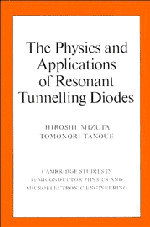Book contents
- Frontmatter
- Contents
- Preface
- 1 Introduction
- 2 Introduction to resonant tunnelling in semiconductor heterostructures
- 3 Scattering-assisted resonant tunnelling
- 4 Femtosecond dynamics and non-equilibrium distribution of electrons in resonant tunnelling diodes
- 5 High-speed and functional applications of resonant tunnelling diodes
- 6 Resonant tunnelling in low-dimensional double-barrier heterostructures
- Index
2 - Introduction to resonant tunnelling in semiconductor heterostructures
Published online by Cambridge University Press: 26 January 2010
- Frontmatter
- Contents
- Preface
- 1 Introduction
- 2 Introduction to resonant tunnelling in semiconductor heterostructures
- 3 Scattering-assisted resonant tunnelling
- 4 Femtosecond dynamics and non-equilibrium distribution of electrons in resonant tunnelling diodes
- 5 High-speed and functional applications of resonant tunnelling diodes
- 6 Resonant tunnelling in low-dimensional double-barrier heterostructures
- Index
Summary
This chapter is intended as an introduction to the fundamental physics of resonant tunnelling diodes (RTDs). The idea of global coherent tunnelling is introduced in order to provide an intuitive and clear picture of resonant tunnelling. The theoretical basis of the global coherent tunnelling model is presented in Section 2.2. The Tsu–Esaki formula, based on linear response theory, is adopted and combined with the transfer matrix method to calculate the tunnelling current through double-barrier resonant tunnelling structures (Section 2.2.1). The global coherent tunnelling model is improved by taking Hartree's selfconsistent field (Section 2.2.2) into account. A more analytical transfer Hamiltonian formula is also presented (Section 2.2.3). Section 2.3 introduces the electron dwell time, which is one of the important quantities required to describe the high-frequency performance of RTDs. The effects of quantised electronic states in the emitter are then studied in Section 2.4. Section 2.5 describes resonant tunnelling through double-well structures. Finally, Section 2.6 discusses the idea of incoherent resonant tunnelling induced by phase-coherence breaking scattering. The problem of collision-induced broadening is then discussed in terms of the peak-to-valley (P/V) current ratio of RTDs by using a phenomenological Breit–Wigner formula.
Resonant tunnelling in double-barrier heterostructures
Let us start with a simple discussion of resonant tunnelling through the double-barrier heterostructure depicted in Fig. 2.1 (a). A resonant tunnelling diode (RTD) typically consists of an undoped quantum well layer sandwiched between undoped barrier layers and heavily doped emitter and collector contact regions.
- Type
- Chapter
- Information
- Publisher: Cambridge University PressPrint publication year: 1995
- 1
- Cited by



